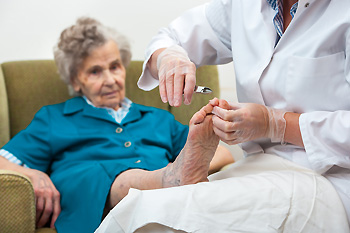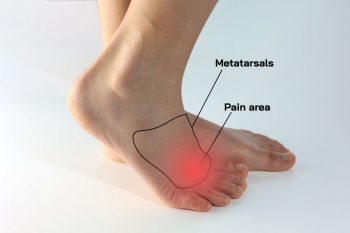Connect With Us
Blog
Items filtered by date: September 2024
Foot Health for Elderly in Long-Term Care Settings

Long-term care for foot health is a critical concern for the elderly, as aging often leads to various foot problems that can impact mobility and overall well-being. Common issues include toenail disorders, dry skin, corns, calluses, and conditions like arthritis or diabetes, which can lead to more severe complications such as foot ulcers or infections. Reduced circulation and nerve sensitivity make it harder for seniors to notice injuries, which can worsen if left untreated. Regular foot care, including proper hygiene, moisturization, and regular inspections, is essential in preventing these issues. In long-term care settings, caregivers play a vital role in maintaining foot health by assisting with daily foot care, ensuring appropriate footwear, and arranging for podiatry visits. Addressing foot problems early on can help maintain mobility, reduce pain, and improve the overall quality of life for elderly individuals. If you are an elderly person living in a long-term care setting, it is suggested that you include a podiatrist among the doctors that you see regularly.
If you need your feet checked, contact James Torhorst, DPM of Torhorst Foot and Ankle. Our doctor will attend to all of your foot and ankle needs and provide you with quality treatment.
Geriatrics and Podiatry
When people age, some common issues that may occur are bone density loss, dry skin, poor circulation, and rough brittle nails. These issues may also affect your foot health if the necessary steps are not taken to alleviate the problems.
It is important to take care of your feet because feet that are injured or diseased can affect your overall health. Having painful feet hinders your ability to do daily activities or may decrease your willingness to do the things that you need to do.
Visiting Your Geriatrician
As we age, health problems become more likely, so it is essential to visit your doctor for check-ups to ensure that you are doing the best you can to take care of your health. It is recommended to check your feet frequently for any possible cuts, bruises, swelling, corns or any other irregularities.
Taking Care of Elderly Feet
Cracked or dry feet can be treated by applying moisturizer often. It is also important not to wear old socks because the older the sock is, the higher the possibility there will be that there is bacteria there. Wear fresh socks and make sure they fit properly.
Proper foot health means that you can have a more active lifestyle and you will not be bogged down by pain. Foot health also leads to good circulation, which is paramount for overall health.
If you have any questions, please feel free to contact our offices located in Waupaca and Stevens Point, WI . We offer the newest diagnostic tools and technology to treat your foot and ankle needs.
Wounds That Don't Heal Need to Be Checked
Common Ankle Injuries in Baseball Players

Foot and ankle injuries are prevalent among baseball players due to the demanding nature of the sport, which involves frequent running, sudden stops, and rapid direction changes. Ankle sprains, particularly lateral ankle sprains, are among the most common injuries. These occur when the ankle rolls outward, stretching or tearing the ligaments on the outside of the ankle. Chronic ankle instability often follows, where the ankle remains prone to repeated sprains and discomfort. This condition can significantly affect a player's performance and recovery. Proper warm-up exercises, strengthening routines, and supportive footwear can help reduce the risk of such injuries. If you have endured this type of injury, your ability to play may be temporarily compromised. It is suggested that you visit a podiatrist who can offer effective relief and treatment remedies.
Sports related foot and ankle injuries require proper treatment before players can go back to their regular routines. For more information, contact James Torhorst, DPM of Torhorst Foot and Ankle. Our doctor can provide the care you need to keep you pain-free and on your feet.
Sports Related Foot and Ankle Injuries
Foot and ankle injuries are a common occurrence when it comes to athletes of any sport. While many athletes dismiss the initial aches and pains, the truth is that ignoring potential foot and ankle injuries can lead to serious problems. As athletes continue to place pressure and strain the area further, a mild injury can turn into something as serious as a rupture and may lead to a permanent disability. There are many factors that contribute to sports related foot and ankle injuries, which include failure to warm up properly, not providing support or wearing bad footwear. Common injuries and conditions athletes face, including:
- Plantar Fasciitis
- Plantar Fasciosis
- Achilles Tendinitis
- Achilles Tendon Rupture
- Ankle Sprains
Sports related injuries are commonly treated using the RICE method. This includes rest, applying ice to the injured area, compression and elevating the ankle. More serious sprains and injuries may require surgery, which could include arthroscopic and reconstructive surgery. Rehabilitation and therapy may also be required in order to get any recovering athlete to become fully functional again. Any unusual aches and pains an athlete sustains must be evaluated by a licensed, reputable medical professional.
If you have any questions please feel free to contact our offices located in Waupaca and Stevens Point, WI . We offer the newest diagnostic and treatment technologies for all your foot and ankle needs.
Understanding Morton’s Neuroma
 Morton's neuroma is a painful foot condition caused by the thickening of the tissue surrounding the nerves leading to the toes, usually between the third and fourth toes. This condition often results from repetitive stress or wearing tight, high-heeled, or narrow shoes, leading to nerve irritation. Symptoms can include burning pain in the ball of the foot, tingling, or numbness in the toes, and discomfort that worsens with walking, standing, or wearing constricting footwear. Diagnosis involves a physical examination, with imaging tests like ultrasounds or MRI scans used to rule out other conditions. Treatment focuses on relieving pressure on the affected nerve. Initial approaches include switching to wider shoes, using orthotic devices, and taking anti-inflammatory medications. In more severe cases, corticosteroid injections or surgical removal of the thickened tissue may be necessary. If you feel you may have Morton's neuroma, it is suggested that you schedule an appointment with a podiatrist for a proper diagnosis and treatment.
Morton's neuroma is a painful foot condition caused by the thickening of the tissue surrounding the nerves leading to the toes, usually between the third and fourth toes. This condition often results from repetitive stress or wearing tight, high-heeled, or narrow shoes, leading to nerve irritation. Symptoms can include burning pain in the ball of the foot, tingling, or numbness in the toes, and discomfort that worsens with walking, standing, or wearing constricting footwear. Diagnosis involves a physical examination, with imaging tests like ultrasounds or MRI scans used to rule out other conditions. Treatment focuses on relieving pressure on the affected nerve. Initial approaches include switching to wider shoes, using orthotic devices, and taking anti-inflammatory medications. In more severe cases, corticosteroid injections or surgical removal of the thickened tissue may be necessary. If you feel you may have Morton's neuroma, it is suggested that you schedule an appointment with a podiatrist for a proper diagnosis and treatment.
Morton’s neuroma is a very uncomfortable condition to live with. If you think you have Morton’s neuroma, contact James Torhorst, DPM of Torhorst Foot and Ankle. Our doctor will attend to all of your foot care needs and answer any of your related questions.
Morton’s Neuroma
Morton's neuroma is a painful foot condition that commonly affects the areas between the second and third or third and fourth toe, although other areas of the foot are also susceptible. Morton’s neuroma is caused by an inflamed nerve in the foot that is being squeezed and aggravated by surrounding bones.
What Increases the Chances of Having Morton’s Neuroma?
- Ill-fitting high heels or shoes that add pressure to the toe or foot
- Jogging, running or any sport that involves constant impact to the foot
- Flat feet, bunions, and any other foot deformities
Morton’s neuroma is a very treatable condition. Orthotics and shoe inserts can often be used to alleviate the pain on the forefront of the feet. In more severe cases, corticosteroids can also be prescribed. In order to figure out the best treatment for your neuroma, it’s recommended to seek the care of a podiatrist who can diagnose your condition and provide different treatment options.
If you have any questions, please feel free to contact our offices located in Waupaca and Stevens Point, WI . We offer the newest diagnostic and treatment technologies for all your foot care needs.
Cause of Pain in the Arch of the Feet

Experiencing pain in the arch of the foot can significantly affect your daily activities, making it difficult to walk or bear weight. This discomfort can stem from various conditions, such as plantar fasciitis, flat feet, or overpronation. Plantar fasciitis, one of the most common reasons, involves inflammation of the plantar fascia, which is the band of tissue running along the bottom of the foot. Flat feet or fallen arches occur when the arch collapses, causing strain and pain due to improper weight distribution. Overpronation, where the foot rolls inward excessively while walking, can also lead to arch pain by overstretching and stressing the ligaments and muscles. Other factors like obesity, wearing improper footwear, and repetitive stress from high-impact activities can contribute to this issue. A podiatrist can examine your arches to determine the case of the discomfort. This medically trained foot doctor specializes in diagnosing and treating foot-related problems, offering personalized treatment plans that may include orthotic devices or specific exercises to alleviate pain and improve foot function. If you are experiencing pain in the arch of the foot, it is suggested that you schedule an appointment with a podiatrist for an exam, diagnosis, and treatment options.
Foot Pain
Foot pain can be extremely painful and debilitating. If you have a foot pain, consult with James Torhorst, DPM from Torhorst Foot and Ankle. Our doctor will assess your condition and provide you with quality foot and ankle treatment.
Causes
Foot pain is a very broad condition that could be caused by one or more ailments. The most common include:
- Bunions
- Hammertoes
- Plantar Fasciitis
- Bone Spurs
- Corns
- Tarsal Tunnel Syndrome
- Ingrown Toenails
- Arthritis (such as Gout, Rheumatoid, and Osteoarthritis)
- Flat Feet
- Injury (from stress fractures, broken toe, foot, ankle, Achilles tendon ruptures, and sprains)
- And more
Diagnosis
To figure out the cause of foot pain, podiatrists utilize several different methods. This can range from simple visual inspections and sensation tests to X-rays and MRI scans. Prior medical history, family medical history, and any recent physical traumatic events will all be taken into consideration for a proper diagnosis.
Treatment
Treatment depends upon the cause of the foot pain. Whether it is resting, staying off the foot, or having surgery; podiatrists have a number of treatment options available for foot pain.
If you have any questions, please feel free to contact our offices located in Waupaca and Stevens Point, WI . We offer the newest diagnostic and treatment technologies for all your foot care needs.

